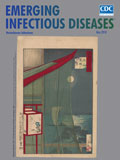
Volume 24, Number 5—May 2018
Letter
Potentially Same Novel Ehrlichia Species in Horses in Nicaragua and Brazil
On This Page
Article Metrics
Altmetric:
Citations: 0
Views: 120Views equals page views plus PDF downloads
Metric DetailsTo the Editor: In our previously published report, we found that blood samples from 4 naturally infected horses in Nicaragua were PCR positive for the 16S rDNA, sodB, and groEL genes of an Ehrlichia species (1). Similarly, Vieira and colleagues reported a potentially novel Ehrlichia sp. infecting horses in South America, with a high seroprevalence in carthorses; 1 horse blood sample was PCR positive for Ehrlichia 16S rDNA and dsb genes (2). Because these 2 studies sequenced different 16S rDNA regions, the Ehrlichia sp. found in Nicaragua could not be established as the same one infecting horses in Brazil.
We retrieved an Ehrlichia PCR-positive horse blood sample (2) from Brazil and performed partial PCR and sequencing of the 16S rDNA, sodb, and groELgenes (1). Phylogenetic analysis of the sequences (3–5) demonstrated a close relationship between the Ehrlichia spp. found in Brazil and Nicaragua, with posterior probability values of 100% for all 3 gene fragments (Technical Appendix[PDF - 376 KB - 2 pages] Figure 1). The 16S rDNA were 100% identical (181 bp/181 bp; GenBank accession no. KJ434178), sodb 99% identical (561 bp/567 bp; GenBank accession nos. MG385129, KJ434180), and groEL 99% identical (579 bp/584 bp; GenBank accession nos. MG385128, KJ434179). When we compared translated amino acid sequences of the Ehrlichia spp. from Brazil and Nicaragua, we observed high percentage identities with the groEL (100%) and sodB (97.8%) alignments (Technical Appendix[PDF - 376 KB - 2 pages] Figure 2). Furthermore, when compared with E. ruminantium, the most closely related Ehrlichia sp. on the basis of phylogenetic analyses, percentage identities from the groEL (94.8%) and sodB (78.8%) alignments were lower for both Ehrlichia spp.
These findings suggest that the novel Ehrlichia spp. found infecting horses in Nicaragua and Brazil are potentially the same species. Future studies are needed to determine cell culture practices, characterize potential clinical signs of infection, and establish the main vector of this novel equine Ehrlichiaspecies.
References
- O’Nion VL, Montilla HJ, Qurollo BA, Maggi RG, Hegarty BC, Tornquist SJ, et al. Potentially novel Ehrlichia species in horses, Nicaragua. Emerg Infect Dis. 2015;21:335–8. DOIPubMed
- Vieira TS, Vieira RF, Krawczak FS, Soares HS, Guimarães AM, Barros-Filho IR, et al. Ehrlichia sp. infection in carthorses of low-income owners, Southern Brazil. Comp Immunol Microbiol Infect Dis. 2016;48:1–5. DOIPubMed
- Sela I, Ashkenazy H, Katoh K, Pupko T. GUIDANCE2: accurate detection of unreliable alignment regions accounting for the uncertainty of multiple parameters. Nucleic Acids Res. 2015;43(W1):W7-14. DOIPubMed
- Drummond AJ, Suchard MA, Xie D, Rambaut A. Bayesian phylogenetics with BEAUti and the BEAST 1.7. Mol Biol Evol. 2012;29:1969–73. DOIPubMed
- Darriba D, Taboada GL, Doallo R, Posada D. jModelTest 2: more models, new heuristics and parallel computing. Nat Methods. 2012;9:772. DOIPubMed






















.png)











No hay comentarios:
Publicar un comentario